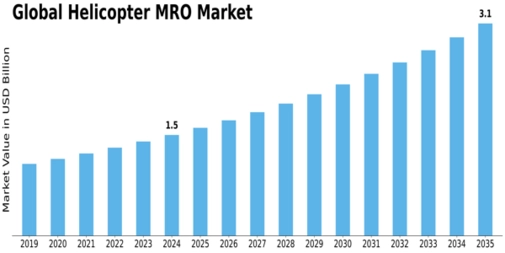Global Helicopter MRO Market Outlook: Trends, Growth Drivers, and Forecast Analysis

While the global helicopter MRO market shows promising growth and opportunity, it is not without challenges and strategic risk factors that operators and service providers must navigate carefully. According to MRFR, the helicopter MRO market is forecast to grow to USD 12.34 billion by 2030 at a 4.55% CAGR. However, several headwinds may shape how that growth plays out.
First, the impact of global events — such as pandemics or economic downturns — can significantly affect helicopter usage, especially in civil segments (tourism, offshore operations, corporate transport). As helicopter flights decline, demand for maintenance and overhaul may temporarily dip, affecting MRO business volumes. Indeed, MRFR had identified the COVID-19 pandemic as a factor that created uncertainty during recovery.
Second, regulatory and environmental pressures can impose additional costs or constraints. As aviation authorities tighten safety, emissions, and maintenance regulations, MRO providers may need to invest in more advanced tooling, training, and compliance infrastructure — increasing their overheads. MRFR points to such regulatory and next-generation helicopter developments as potential restraints.
Third, the increasing complexity of modern helicopters — newer engines, composite materials, advanced avionics — demands high technical capability for maintenance and overhaul. MRO firms unable to keep pace may lose competitiveness. For smaller MRO providers, investing in the required certification, spare-parts inventory, and skilled workforce may be challenging.
Fourth, geographic disparities pose risk: while emerging regions like Asia-Pacific offer growth potential, infrastructure, regulatory harmonization, supply-chain logistics (for spare-parts), trained manpower, and capital investment remain uneven. Establishing a reliable maintenance hub in these regions requires long-term commitment and risk management.
Given these challenges, what strategic actions make sense for practitioners? — Diversify service offerings: focusing not only on line maintenance but also heavy airframe overhaul, component and engine rebuilding, and specialized services for heavy helicopters. — Invest in compliance and training: stay ahead on safety, regulatory norms, certification, and upgrade tooling/training. — Form partnerships or alliances: with OEMs or specialized parts suppliers to ensure spare-parts availability and technical backing. — Expand regionally but cautiously: set up maintenance hubs in emerging markets only after careful evaluation of demand, regulatory environment, and supply-chain readiness.
In conclusion, the helicopter MRO market presents a stable growth path and valuable opportunities. But success will demand foresight: for MRO providers to balance growth ambitions with strategic investments, regulatory readiness, and the ability to weather market fluctuations. The forecast to 2030 gives a firm yardstick — but long-term success will rely on building resilience, technical capability, and strategic positioning.
Related Report:
Aerospace & Defense Fluid Conveyance Systems Market OverView
Commercial Satellite Launch Service Market OverView
Aircraft Communication System Market OverView
Air Defense System Market OverView
- Art
- Causes
- Crafts
- Dance
- Drinks
- Film
- Fitness
- Food
- Oyunlar
- Gardening
- Health
- Home
- Literature
- Music
- Networking
- Other
- Party
- Religion
- Shopping
- Sports
- Theater
- Wellness


